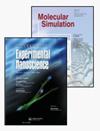基于3D-QSAR、分子对接和分子动力学模拟的秋水仙碱衍生物抗肿瘤抑制剂研究
IF 2
4区 化学
Q4 CHEMISTRY, PHYSICAL
引用次数: 0
摘要
摘要微管蛋白是抗肿瘤药物的重要研究靶点,可用于抑制微管蛋白的聚合,提高肿瘤治疗的疗效。本文选取61个具有抗癌活性的微管蛋白抑制剂作为数据集,构建稳定有效的QSAR (Topomer CoMFA)模型,得到验证系数q2 = 0.737, r2 = 0.922的Topomer CoMFA模型。通过Topomer CoMFA获得的贡献描述符筛选锌数据库中具有良好活性的新片段,设计了15种理论上具有高活性的新抑制剂。通过分子对接模拟抑制剂与蛋白质的结合亲和力和相互作用后,这些化合物均与受体蛋白中的多个氨基酸形成氢键等强相互作用。此外,分子动力学结果表明,预测的高活性化合物与活性口袋具有稳定和良好的结合模式。此外,这些新化合物还具有良好的ADMET性能。本研究为微管蛋白药物开发的计算模拟筛选建立了可靠的QSAR模型,为进一步获得新型微管蛋白抑制剂提供了基础。关键词:微管蛋白抑制剂;秋水仙碱;聚物;分子对接;本研究由国家自然科学基金资助:[批准号21475081];陕西科技大学研究生创新基金;国家自然科学基金项目(22373062);本文章由计算机程序翻译,如有差异,请以英文原文为准。
Exploration of anti-tumour inhibitors from colchicine derivatives based on 3D-QSAR, molecular docking and molecular dynamics simulations
ABSTRACTMicrotubulin is an important research target for anti-tumour drugs, which can be used to inhibit microtubulin polymerisation and improve the efficacy of tumour therapy. In this paper, 61 microtubule protein inhibitors with anticancer activity are selected as the data set for building a stable and effective QSAR (Topomer CoMFA) model, resulting in a Topomer CoMFA model with validation coefficients of q2 = 0.737 and r2 = 0.922. Fifteen new inhibitors with theoretically high activity are designed by screening the zinc database for new fragments with good activity through the contribution descriptors obtained by Topomer CoMFA. After simulating the binding affinity and interaction of the inhibitors with the proteins by molecular docking, all these compounds formed strong interactions such as hydrogen bonds with multiple amino acids in the receptor proteins. Furthermore, molecular dynamics results show that the predicted highly active compounds exhibited stable and favourable binding patterns to the active pocket. In addition, these new compounds exhibit good ADMET properties. The present work establishes a reliable QSAR model for computational simulation screening of microtubulin drug development and provides a basis for further access to novel microtubulin inhibitors.KEYWORDS: Microtubule protein inhibitorColchicineTopomer coMFAMolecular dockingMolecular dynamics Disclosure statementThe authors declare that they have no conflict of interest.(s).Additional informationFundingThis work was supported by National Natural Science Foundation of China: [Grant Number 21475081]; Graduate Innovation Fund of Shaanxi University of Science and Technology; The National Natural Science Foundation of China (22373062).
求助全文
通过发布文献求助,成功后即可免费获取论文全文。
去求助
来源期刊

Molecular Simulation
化学-物理:原子、分子和化学物理
CiteScore
3.80
自引率
9.50%
发文量
128
审稿时长
3.1 months
期刊介绍:
Molecular Simulation covers all aspects of research related to, or of importance to, molecular modelling and simulation.
Molecular Simulation brings together the most significant papers concerned with applications of simulation methods, and original contributions to the development of simulation methodology from biology, biochemistry, chemistry, engineering, materials science, medicine and physics.
The aim is to provide a forum in which cross fertilization between application areas, methodologies, disciplines, as well as academic and industrial researchers can take place and new developments can be encouraged.
Molecular Simulation is of interest to all researchers using or developing simulation methods based on statistical mechanics/quantum mechanics. This includes molecular dynamics (MD, AIMD), Monte Carlo, ab initio methods related to simulation, multiscale and coarse graining methods.
 求助内容:
求助内容: 应助结果提醒方式:
应助结果提醒方式:


